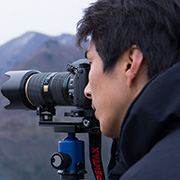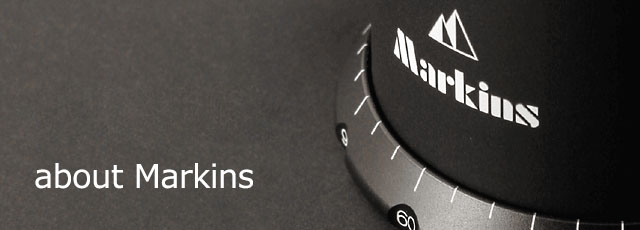Toshihiro Hayashi | Markins Ball Head
Theme
Nature landscape photography
Photographer
Toshihiro Hayashi
( http://tramping.exblog.jp/ )
Date
April 30, 2012
Location
Utatsuzaki, Minamisanriku Town, Miyagi
Device
Markins
Pentax
K-5
DA★ 16-50mm F2.8, DA★ 50-135mm F2.8
DA★ 16-50mm F2.8, DA★ 50-135mm F2.8
Gitzo
GT1530
Review

The main subject I photograph is landscapes.
Although it is generally believed that 3-way heads are the best for landscape photography, I have always preferred to use ball heads.
Although 3-way heads have the advantage of being easy to level and allowing for precise framing, ball heads, which allow for free framing without being bound by the vertical and horizontal axes, suit my shooting style better.
Ball heads require smooth ball movement so that you can move the camera as you wish.
On the other hand, when you have decided on the composition, you need the opposing strength of holding the camera without moving it.
The ideal ball head would be one that strikes a good balance between these two, but it seems that this is not so easy to achieve.
The model I got this time was the Q10 (old model) blue color, which is no longer available, but I attached it to a tripod and actually took some photos in the field.
When I use a ball head, the most important thing is, of course, the smoothness of the ball movement, but also whether I can stop it smoothly and reliably at the intended position when I need to make subtle position adjustments to frame the shot.
Normally, I release the tightening torque on the ball so that the ball can move freely and without stress.
However, when subtle movements are required, the weight of the camera and lens makes operation difficult.
In that case, I adjust the movement by tightening the main knob a little more, but with this Markins, the movement of the ball was very good when I turned the knob arbitrarily to apply moderate friction.
A common problem with previous ball heads was that when I tried to move it a little, it moved more than necessary, or it didn't move at all, but with this Markins, I can control the subtle movements I intend.
Another important thing is that the camera doesn't move at all when you decide on the framing and tighten the main knob to fix the ball.
With the tripod head I had been using, when I let go of the camera after tightening the ball, the lens would move downward, although I think it was only a few tenths of a millimeter.
This movement is hardly noticeable when shooting with a wide-angle lens, but when shooting with a telephoto lens of 300mm or more, this slight movement can have some effect on the framing.
When I actually shot with a 300mm (APS-C) telephoto lens, the weight of the lens did not cause it to point downward at all, even when I let go of the camera after tightening it. (This also applies when the VR Holder is not in use.)
This head also has a torque limit dial, which can be tightened to the desired tightening strength (friction) to prevent the main knob from turning any further even if you try to loosen the knob.
By setting this friction, you can prevent the camera from suddenly moving with a jerk, even if you accidentally loosen the main knob while your hands are off the camera.
In other words, you can move the ball with moderate friction to decide on the framing, and then release your hands to fix the camera and take a picture. (Although this is not the correct way to use it, as the fixation is insufficient.)
The VR-Holder was used along with the head this time.
When shooting with a telephoto lens such as 300mm, or when shooting with a macro lens extended at close to life size, even the slightest movement of the lens can cause blurring.
In such cases, you can use the VR-Holder to eliminate the cause of the blur.
Markins products are robust yet very light and compact, and can be easily attached to the camera and tripod head.
By using the VR-Holder to place the center of gravity of the camera and lens in the center of the tripod head, not only does it reduce blur but it also improves operability when framing, so I felt its value very much when shooting.
After actually using it for a series of shoots this time, I was reminded that it is not only beautiful like a work of art, but is also a product that is finished with advanced technology and is without a doubt a product.
I would like to continue using it as an important tool that I cannot do without in my future photography.
Although it is generally believed that 3-way heads are the best for landscape photography, I have always preferred to use ball heads.
Although 3-way heads have the advantage of being easy to level and allowing for precise framing, ball heads, which allow for free framing without being bound by the vertical and horizontal axes, suit my shooting style better.
Ball heads require smooth ball movement so that you can move the camera as you wish.
On the other hand, when you have decided on the composition, you need the opposing strength of holding the camera without moving it.
The ideal ball head would be one that strikes a good balance between these two, but it seems that this is not so easy to achieve.
The model I got this time was the Q10 (old model) blue color, which is no longer available, but I attached it to a tripod and actually took some photos in the field.
When I use a ball head, the most important thing is, of course, the smoothness of the ball movement, but also whether I can stop it smoothly and reliably at the intended position when I need to make subtle position adjustments to frame the shot.
Normally, I release the tightening torque on the ball so that the ball can move freely and without stress.
However, when subtle movements are required, the weight of the camera and lens makes operation difficult.
In that case, I adjust the movement by tightening the main knob a little more, but with this Markins, the movement of the ball was very good when I turned the knob arbitrarily to apply moderate friction.
A common problem with previous ball heads was that when I tried to move it a little, it moved more than necessary, or it didn't move at all, but with this Markins, I can control the subtle movements I intend.
Another important thing is that the camera doesn't move at all when you decide on the framing and tighten the main knob to fix the ball.
With the tripod head I had been using, when I let go of the camera after tightening the ball, the lens would move downward, although I think it was only a few tenths of a millimeter.
This movement is hardly noticeable when shooting with a wide-angle lens, but when shooting with a telephoto lens of 300mm or more, this slight movement can have some effect on the framing.
When I actually shot with a 300mm (APS-C) telephoto lens, the weight of the lens did not cause it to point downward at all, even when I let go of the camera after tightening it. (This also applies when the VR Holder is not in use.)
This head also has a torque limit dial, which can be tightened to the desired tightening strength (friction) to prevent the main knob from turning any further even if you try to loosen the knob.
By setting this friction, you can prevent the camera from suddenly moving with a jerk, even if you accidentally loosen the main knob while your hands are off the camera.
In other words, you can move the ball with moderate friction to decide on the framing, and then release your hands to fix the camera and take a picture. (Although this is not the correct way to use it, as the fixation is insufficient.)
The VR-Holder was used along with the head this time.
When shooting with a telephoto lens such as 300mm, or when shooting with a macro lens extended at close to life size, even the slightest movement of the lens can cause blurring.
In such cases, you can use the VR-Holder to eliminate the cause of the blur.
Markins products are robust yet very light and compact, and can be easily attached to the camera and tripod head.
By using the VR-Holder to place the center of gravity of the camera and lens in the center of the tripod head, not only does it reduce blur but it also improves operability when framing, so I felt its value very much when shooting.
After actually using it for a series of shoots this time, I was reminded that it is not only beautiful like a work of art, but is also a product that is finished with advanced technology and is without a doubt a product.
I would like to continue using it as an important tool that I cannot do without in my future photography.

Night sky and the sea at dawn (Utatsuzaki, Minamisanriku-cho, Miyagi)




